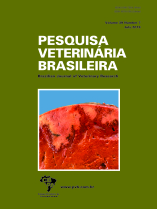 |
|
|
|
Year 2019 - Volume 39, Number 7
|

|
Epidemiological study of rabies in cattle in southern Brazil: spatial and temporal distribution from 2008 to 2017, 39(7):460-468
|
ABSTRACT.- Santos B.L., Bruhn F.R.P., Coelho A.C.B., Estima-Silva P., Echenique J.Z., Sallis E.S.V. & Schild A.L. 2019. Epidemiological study of rabies in cattle in southern Brazil: spatial and temporal distribution from 2008 to 2017. [Estudo epidemiológico da raiva em bovinos no Sul do Brasil: distribuição espacial e temporal de 2008 a 2017.] Pesquisa Veterinária Brasileira 39(7):460-468. Laboratório Regional de Diagnóstico, Faculdade de Veterinária, Universidade Federal de Pelotas, Campus Universitário s/n, Pelotas, RS 96010-900, Brazil. E-mail: alschild@terra.com.br
Rabies affects several domestic species, causing significant economic losses due to the death of animals in characteristic areas of the southern region of Rio Grande do Sul. In this context, this work aimed to study the epidemiology of rabies outbreaks observed in cattle from January 2008 to December 2017, through its space and time distribution in the southern region of Rio Grande do Sul. We performed an observational and ecological retrospective through the analysis of data recorded in necropsy protocols performed in cattle at the "Laboratório Regional de Diagnóstico" of the "Universidade Federal de Pelotas" (LRD UFPel). A descriptive data analysis aimed at evaluating the distribution of cases over time. The statistical analysis was performed with Gretl statistical software 1.9.12 (GNU Regression, Econometric, and Time-series Library). To the existence of stationarity was verified with the Dickey-Fuller test, considering a value of p<0.05. From January 2008 to December 2017, 1418 bovine diagnostic materials were received at the LRD-UFPel, and 160 outbreaks of rabies were confirmed in 160 farms located in the 24 municipalities of the LRD-UFPel area of influence. We observed 591 cattle out of a total of 25,886 infected with the virus. We conclude that rabies does not exhibit seasonality in the study region, with a tendency to decrease in frequency in the next years. The disease has an epidemic characteristic in most of the analyzed months (2012 2014), remaining endemic in the remaining period (2011, 2015 and 2016) with sporadic episodes of epidemics in these years. We also observed that as the incidence of the disease increased in the animals and in the properties, there was a geographical spread of the virus for the majority (54.16%) of the municipalities in the area of influence of the LRD-UFPel. |
| |
|
|
| |
|
 |